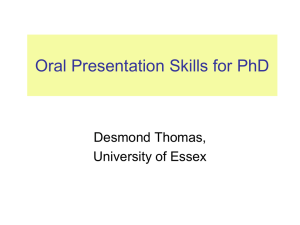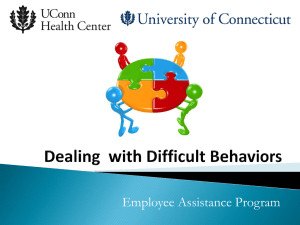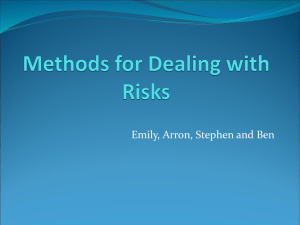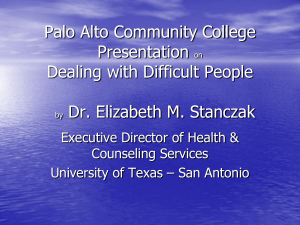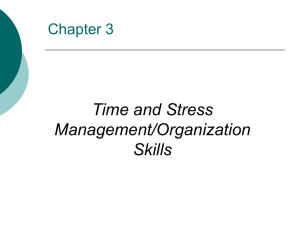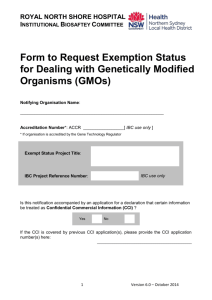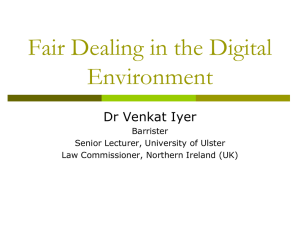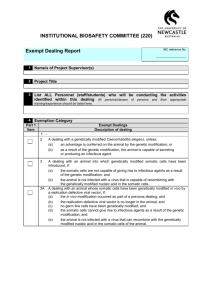Application for Exempt and NLR Dealing
advertisement
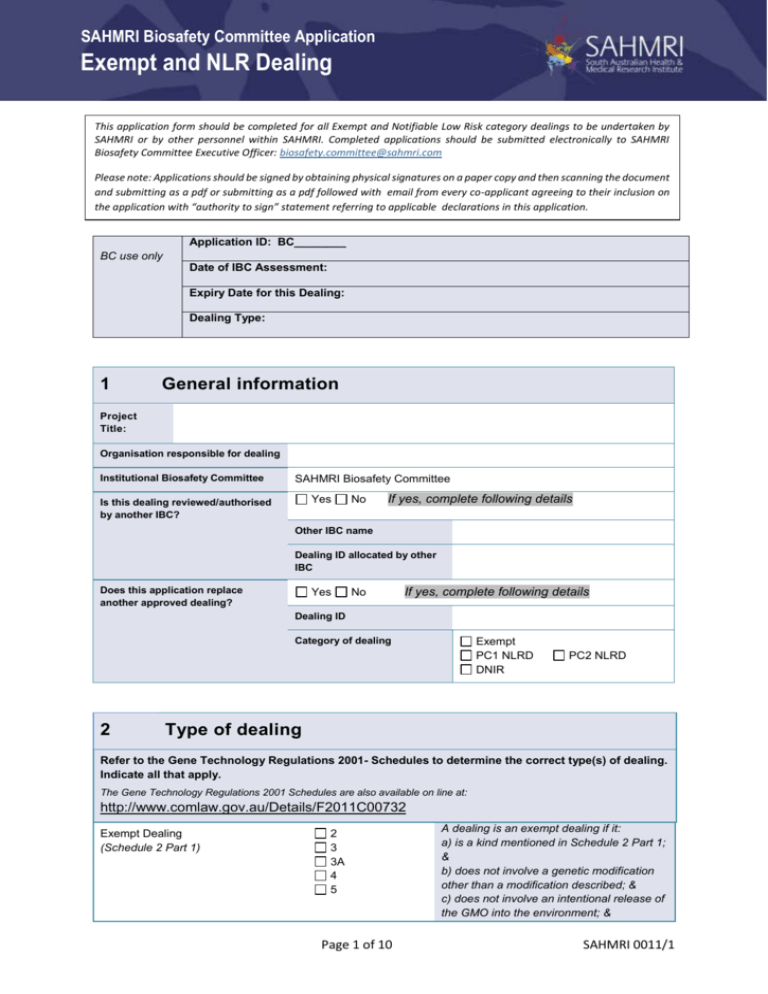
SAHMRI Biosafety Committee Application Exempt and NLR Dealing This application form should be completed for all Exempt and Notifiable Low Risk category dealings to be undertaken by SAHMRI or by other personnel within SAHMRI. Completed applications should be submitted electronically to SAHMRI Biosafety Committee Executive Officer: biosafety.committee@sahmri.com Please note: Applications should be signed by obtaining physical signatures on a paper copy and then scanning the document and submitting as a pdf or submitting as a pdf followed with email from every co-applicant agreeing to their inclusion on the application with “authority to sign” statement referring to applicable declarations in this application. Application ID: BC________ BC use only Date of IBC Assessment: Expiry Date for this Dealing: Dealing Type: 1 General information Project Title: Organisation responsible for dealing Institutional Biosafety Committee SAHMRI Biosafety Committee Yes Is this dealing reviewed/authorised by another IBC? No If yes, complete following details Other IBC name Dealing ID allocated by other IBC Does this application replace another approved dealing? Yes No If yes, complete following details Dealing ID Category of dealing 2 Exempt PC1 NLRD DNIR PC2 NLRD Type of dealing Refer to the Gene Technology Regulations 2001- Schedules to determine the correct type(s) of dealing. Indicate all that apply. The Gene Technology Regulations 2001 Schedules are also available on line at: http://www.comlaw.gov.au/Details/F2011C00732 Exempt Dealing (Schedule 2 Part 1) 2 3 3A 4 5 Page 1 of 10 A dealing is an exempt dealing if it: a) is a kind mentioned in Schedule 2 Part 1; & b) does not involve a genetic modification other than a modification described; & c) does not involve an intentional release of the GMO into the environment; & SAHMRI 0011/1 SAHMRI Biosafety Committee Application Exempt and NLR Dealing d) does not involve a retroviral vector that is able to transduce human cells Notifiable Low Risk Dealing – PC1 (Schedule 3 Part 1) 1.1(a) Notifiable Low Risk Dealing – PC2 (Schedule 3 Part 2.1) 2.1(a) 1.1 (c) 2.1(b) 2.1(c) 2.1(d) 2.1(e) 2.1(f) 2.1(g) 2.1(j) 2.1(m) Notifiable Low Risk Dealing – PC3 (Schedule 3 Part 2.2) 2.1(h) 2.1(i) 2.1(k) 2.1(l) 2.2 A dealing is not a notifiable low risk dealing if it: a) is also a dealing of a kind mentioned in Part 3 of Schedule 3; or b) involves an intentional release of the GMO into the environment. A dealing that is not an exempt dealing or a notifiable low risk dealing must be authorised under an OGTR licence. If yes please contact IBC Executive Officer before proceeding further 3 Project staff details Project supervisor Address Telephone Email address Has the project supervisor previously submitted a dealing application to this IBC? 4 Yes No If no, please provide as an attachment a brief one page resume outlining relevant experience and qualifications in relation to GMO work. About the dealing Please ensure the information provided, including the description, accurately includes all aspects of the dealing. Investigators should ensure that all storage and proposed transport, including importation or exportation, of GMOs is included in the dealing as these aspects of a dealing also require approval. Please include the aims of the proposed dealing, method of producing GMOs and their use. If more than one type of dealing is included on this application, please ensure that the work associated with each dealing type is clearly identified and outlined. NOTE: Please use lay language to clearly describe your project. Proposed commencement date Expected completion date Description of work Page 2 of 10 SAHMRI 0011/1 SAHMRI Biosafety Committee Application Exempt and NLR Dealing Benefits of the work (a brief statement in lay terms – no more than 200 words/15 lines of text) Description of the dealing Conduct experiments with the GMO Only dealings that are listed on an authorisation can be undertaken. Therefore, please ‘check’ the dealings that will be undertaken. Make, develop, produce or manufacture the GMO NOTE: A dealing includes the possession, supply or use of the GMO, for the purposes of, or in the course of, a dealing mentioned in any of paragraphs listed. Breed the GMO Propagate the GMO Use the GMO in the course of manufacture of a *As defined in the Gene Technology Act 2000: thing, includes a substance, and a thing in electronic or magnetic form. thing* that is not the GMO If yes, complete following details Is the thing* subject to regulation by other agencies (e.g. Food Standards Australia, Australian Pesticides and Veterinary Medicines Association, Therapeutic Goods Administration) Yes Agency No Grow, raise or culture the GMO Import the GMO If yes, complete following details Is the import subject to AQIS approval? Yes AQIS Import Permit ID No Transport the GMO Dispose of the GMO Store the GMO 5 About the GMOs Select all hosts and vectors that apply from the list of Host/vector systems for exempt dealings – Part 2 of Schedule 2. Item Class Host (select all that apply) Vector (select all that apply) 1 Bacteria Escherichia coli K12, E. coli B or E. coli C or E. coli Nissle 1917 – any derivative that does not contain: (a) generalised transducing phages; or (b) genes able to complement the 1. Non-conjugative plasmids 2. Bacteriophage (a) lambda (b) lambdoid (c) Fd or F1 (eg M13) 3. None (non-vector systems) Page 3 of 10 SAHMRI 0011/1 SAHMRI Biosafety Committee Application Exempt and NLR Dealing conjugation defect in a non-conjugative plasmid Bacillus – specified species – asporogenic strains with a reversion frequency of less than 10–7: (a) B. amyloliquefaciens (b) B. licheniformis (c) B. pumilus (d) B. subtilise (e) B. thuringiensis Pseudomonas putida – strain KT 2440 2 Fungi 1. Non-conjugative plasmids 2. Plasmids and phages whose host range does not include B. cereus, B. anthracis or any other pathogenic strain of Bacillus 3. None (non-vector systems) 1. Non-conjugative plasmids including certified plasmids: pKT 262, pKT 263, pKT 264 2. None (non-vector systems) Streptomyces – specified species: (a) S. aureofaciens (b) S. coelicolor (c) S. cyaneus (d) S. griseus (e) S. lividans (f) S. parvulus (g) S. rimosus (h) S. venezuelae 1. Non-conjugative plasmids 2. Certified plasmids: SCP2, SLP1, SLP2, PIJ101 and derivatives 3. Actinophage phi C31 and derivatives 4. None (non-vector systems) Agrobacterium radiobacter Agrobacterium rhizogenes — disarmed strains Agrobacterium tumefaciens — disarmed strains 1. Non-tumorigenic disarmed Ti plasmid vectors, or Ri plasmid vectors 2. None (non-vector systems) Lactobacillus Lactococcus lactis Oenococcus oeni syn. Leuconostoc oeni Pediococcus Photobacterium angustum Pseudoalteromonas tunicate Rhizobium (including the genus Allorhizobium) Sphingopyxis alaskensis syn. Sphingomonas alaskensis Streptococcus thermophilus Synechococcus — specified strains: (a) PCC 7002 (b) PCC 7942 (c) WH 8102 Synechocystis species — strain PCC 6803 Vibrio cholerae CVD103-HgR 1. Non-conjugative plasmids 2. None (non-vector systems) Kluyveromyces lactis Neurospora crassa – laboratory strains Pichia pastoris Saccharomyces cerevisiae 1. All vectors 2. None (non-vector systems) Page 4 of 10 SAHMRI 0011/1 SAHMRI Biosafety Committee Application Exempt and NLR Dealing Schizosaccharomyces pombe Trichoderma reesei Yarrowia lipolytica 3 Slime moulds 4 Tissue culture Dictyostelium species 1. Dictyostelium shuttle vectors, including those based on the endogenous plasmids Ddp1 and Ddp2 2. None (non-vector systems) Any of the following if they cannot spontaneously generate a whole animal: (a) animal or human cell cultures (including packaging cell lines); (b) isolated cells, isolated tissues or isolated organs, whether animal or human; (c) early non-human mammalian embryos cultured in vitro 1. Non-conjugative plasmids 2. Non-viral vectors, or replication defective viral vectors unable to transduce human cells 3. Baculovirus (Autographa californica nuclear polyhedrosis virus), polyhedrin minus 4. None (non-vector systems) Either of the following if they are not intended, and are not likely without human intervention, to vegetatively propagate, flower or regenerate into a whole plant: (a) plant cell cultures; (b) isolated plant tissues or organs 1. Non-tumorigenic disarmed Ti plasmid vectors, or Ri plasmid vectors, in Agrobacterium tumefaciens, Agrobacterium radiobacter or Agrobacterium rhizogenes 2. Non-pathogenic viral vectors 3. None (non-vector systems) Source(s) and type(s) of DNA Scientific name of parent organism The parent organism means the organism that you propose to genetically modify. It also includes intended host cells, e.g. tissue culture cells or host animal cells transduced by a vector. Vector(s) and method of transfer Please provide copies of references or vector maps for novel vectors or methods of transfer. For dealings involving viral vectors please provide details of each of the plasmids to be used. Identity and function of nucleic acid & organism of origin Modified trait(s) and gene(s) responsible Class of modified trait (select all that apply) Details Abiotic stress resistance Altered agronomic characteristics Altered biocontrol characteristics Altered bioremediation characteristics Page 5 of 10 SAHMRI 0011/1 SAHMRI Biosafety Committee Application Exempt and NLR Dealing Altered biosensor characteristics Altered horticultural characteristics Altered nutritional characteristics Altered pharmaceutical characteristics Altered physical product characteristics Altered physiological characteristics Antibiotic resistance Antigen expression Attenuation Bacterial resistance Disease resistance Fungal resistance Growth factor expression Herbicide tolerance Immuno -modulatory protein expression Pest resistance Pesticide resistance Protein expression Reporter/marker gene expression Virus resistance Other 6 Risk assessment and management Describe the risks the proposed dealings pose to the health and safety of people and the environment (no more than 200 words/15 lines of text) Describe the possible hazard(s) and the likelihood and consequence of the hazard(s) occurring (ie the risk) from an unintentional release of the GMO(s) (no more than 200 words/15 lines of text) Please indicate the relevant Risk Group(s) (as per AS/NZS 2243:3:2010Safety in Laboratories) for all No microorganisms involved in this dealing Risk Group 1 micro-organisms involved in this dealing Page 6 of 10 SAHMRI 0011/1 SAHMRI Biosafety Committee Application Exempt and NLR Dealing micro-organisms involved in this dealing. Select all that apply. You can obtain the access to the Standard through the IBC 7 Risk Group 2 micro-organisms involved in this dealing Risk Group 3 micro-organisms involved in this dealing Risk Group 4 micro-organisms involved in this dealing Persons undertaking the dealing The IBC must assess whether the persons or categories of persons have appropriate training and experience to undertake the dealing. This includes persons beyond the persons conducting the research, such as persons involved in importation, transportation and disposal of GMOs. Indicate the categories of persons that will be involved with the dealing. For each relevant category list the name and staff/student for persons known at the time of writing this application. Details of additional persons can be added later as they become known/involved with the dealing. Research staff Students Name Name Other persons Personnel of the facilities listed on this application Name Do all personnel involved in the dealing have appropriate training and experience? NOTE: Appropriate training includes requirements of OGTR Physical Containment Facility Guidelines, OGTR Guidelines for the transport, storage and disposal of GMOs as well as any specialist training for working with the particular GMOs involved in the dealing and procedures covering facilities where the dealing will be undertaken 8 Yes No If no, complete following details What measures are in place to ensure all personnel are adequately trained before commencing the dealing? Facilities to be used All facilities to be used, including places of storage, must be authorised. Storage of GMOs outside of a certified PCx facility is permitted, but must be authorised by the IBC. Unauthorised storage of GMOs is an offence under the Act. Facility 1 Facility 2 Page 7 of 10 Facility 3 SAHMRI 0011/1 SAHMRI Biosafety Committee Application Exempt and NLR Dealing OGTR Certified? Yes No Yes No Yes No OGTR Certification No. Room Number(s) Building Type of facility & PC level Facility Contact Experiments / aspects of dealing to be performed in this facility Facility 4 OGTR Certified? Yes Facility 5 No Yes Facility 6 No Yes No OGTR Certification No. Room Number(s) Building Type of facility & PC level Facility Contact Experiments / aspects of dealing to be performed in this facility 9 Comments for the IBC 10 Project Supervisor Declaration Please initial each of the following statements to indicate that you understand your responsibilities and then sign the application form. I have read, considered and understand my responsibilities under the Gene Technology Act 2000 and agree to undertake the dealing outlined in this application in accordance with the relevant Office of the Gene Technology Regulator guidelines and regulations (including, but not limited to all disposal, transport and storage). http://www.ogtr.gov.au/ I am aware of my responsibilities in relation to ensuring that any personnel conducting this work are appropriately trained and are aware of and also follow the relevant guidelines and regulations. Page 8 of 10 SAHMRI 0011/1 SAHMRI Biosafety Committee Application Exempt and NLR Dealing I have considered the potential risks that the conduct of this dealing could pose to people and/or the environment and will implement appropriate actions and precautions to minimise these risks. Where dealing is received from sources outside the institution responsible for the project, I will take steps to confirm its identity. In the event of an unintentional release of dealing I am aware that I must put into place the appropriate responses to contain the release and I will inform the IBC as soon as practicable of any incidents, accidents or unintentional releases involving GMOs. I am aware that breaches of the legislation are serious matters and that penalties could include loss of OGTR Accreditation status for the organisation, imprisonment and/or substantial fines. Project Supervisor Name 11 Project Supervisor Signature Date Facility Manager Declaration As Facility Manager I have been informed of the nature of and risks involved with this dealing and after consideration of them, I hereby consent to the work being performed in the listed facility. I will ensure that the appropriate safety procedures are followed and that personnel are appropriately trained prior to undertaking work in the listed facility. In the event of an unintentional release of dealing I am aware that I must put into place the appropriate responses to contain the release and I will inform the IBC as soon as practicable of any incidents, accidents or unintentional releases involving GMOs. Facility 1 Facility Manager Name Facility 1 Facility Manager Signature Date Facility 2 Facility Manager Name Facility 2 Facility Manager Signature Date Facility 3 Facility Manager Name Facility 3 Facility Manager Signature Date Facility 4 Facility Manager Name Facility 4 Facility Manager Signature Date Facility 5 Facility Manager Name Facility 5 Facility Manager Signature Date Facility 6 Facility Manager Name Facility 6 Facility Manager Signature Date 12 Senior Manager Declaration As the Senior Manager responsible for the research activities of the project supervisor, I have been informed of the nature of and risks involved with this dealing and after consideration of them, I hereby consent to the work. Page 9 of 10 SAHMRI 0011/1 SAHMRI Biosafety Committee Application Exempt and NLR Dealing Senior Manager Name Senior Manager Signature Date Page 10 of 10 SAHMRI 0011/1

